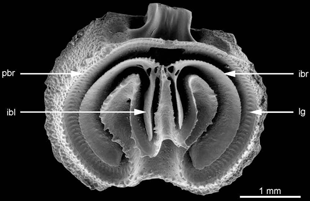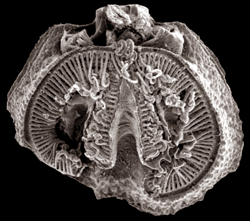|
Ospreyella depressa Lüter, 2003 in Lüter et al., 2003
Type locality: submarine caves at Osprey Reef, Queensland, Australia.
Depth range: 15 - 20 m.
Diagnosis - in Lüter et al., 2003
Dorsal valve with median depression. Median ramus concave, basally connected to dorsal part of the interbrachial ridge, whilst ascending it bends back towards the posterior bridge, forming small jugum at its end. Ramuli very short , slightly reticulated, directly attached to left and right parts of median ramus, together with basal part of median ramus the short ramuli build the basis of the central part of lophophore-supporting apparatus.
Two major interbrachial lobes with strongly serrated and denticulated edges. Two minor interbrachial lobes wuth branches. Branches surrounded by thin calcified walls; walls without connection to the median part of the dorsal valve's floor, wall's edges with irregular tubercules and protuberances becoming more conspicious with maturity of the animal.
Dioecious
|
|
|
Ospreyella maldiviana Logan, 2005
Type locality: submarine caves at Addu Atoll and South Male Atoll in the Maldives Islands
Depth range: 24 - 39 m.
Diagnosis - Logan, 2005
Shell small. Dorsal valve interior with a shallow-sided median ramus, about one-third as wide as the valve width, attached by a broad base (up to two-thirds length of valve) to the dorsal valve floor and gradually widening anteriorly ro terminate in a narrow, almost imperceptible median depression. The median ramus of the brachidium interdigitates in regular fashion with up to four branches of two minor interbrachial lobes on eiher side. The ramulus and major interbrachial lobes are massive and deeply incised, with edges slightly spinose rather than stringly denticulate.
Dioecious
|
|
|
Ospreyella palauensis Logan, 2008
Type locality: Chandelier cave (10 m), Koror Island, Republic of Belau
Depth range: 10 - 18 m.
Diagnosis - Logan, 2008
Shell small; typically lacazelline in appearance and internal structure, dorsal valve interior diagnostic, characterised by median ramus with concave top, narrow posteriorly, gradually widening anteriorly to terminate at about 2/3 valve length, occasionally with frilled margins and/or a divergent process at anterior end; ramus upraised and attached by narrow base to dorsal valve floor; anterior median depression absent or poorly developed; minor interbrachial lobes short, subparallel, rarely furcating; ramulus and major interbrachial lobes massive, well defined with finely spinose edges.
Dioecious
|
|
|
Ospreyella mutiara Simon & Hoffmann, 2013
Type locality: Shipwreck “Mutiara” (30 m) - Bay of Palu, off Donggala Harbour, Donggala near Palu, Province of Central Sulawesi, Indonesia
Depth range: 30 m
Diagnosis - Simon & Hoffmann, 2013
Small- to medium-sized thecideide brachiopod (maximum size = 4.0 mm). Female shells larger than male shells and with a more complete ontogenetic development. Shell whitish, ventribiconvex, slightly uniplicate anteriorly. Ventral valve with short, triangular, convex pseudodeltidium, anterior part with numerous irregular cavities. Sulcus present in most specimens. Ventral valve floor median ridge absent. Hemispondylium formed by two pointed lateral prongs and a prominent median myophragma; supporting structure of hemispondylium absent in adults. Dorsal valve with narrow and straight median ramus with subparallel frilled margins; ramuli relatively narrow, slightly curved, with spiny margins; ventral side of ramus and ramuli weakly convex. Anterior median depression reduced, narrow, anterior margin tuberculated. Minor interbrachial lobes often asymmetrical, straight, short, subparallel, never furcated. Major interbrachial lobes relatively thin with dentate outer margins. Lophophore ptycholophous.
Hermaphroditic
|
|
|
Ospreyella mayottensis Simon, Hiller, Logan & Mottequin, 2019
Type locality: Department of Mayotte (France). Submarine cave at 23 m depth situated at "La Passe bateau" off the SW coast of the Island of Mayotte in the second coral reef barrier - 12°58'39.36"S, 44°58'57.72"E
Depth range: 23 m
? Lacazella mauritiana Dall, 1920: Zezina (1987, p. 56, tab. 1).
Diagnosis - from Simon et al., 2019
Medium-sized thecideide brachiopod (adult shell length around 3–5 mm). Female shells are as large as male shells and with similar complete ontogenetic development (gonochoristic species). Shell whitish, ventribi- convex, rectimarginate anteriorly.
Ventral valve with well-developed, triangular, convex rugideltidium, anterior part with numerous irregular cavi- ties. Faint anterior sulcus present in some specimens, absent in others. Median ridge in the ventral valve present. Ventral valve floor with two types of spines. Hemispondylium formed by two inwardly concave, pointed, lateral prongs and a prominent median myophragm; no supporting structure of the hemispondylium is observed.
Dorsal valve with narrow and straight median ramus with subparallel frilled margins and concave ventral sur- face; ramuli much wider than median ramus, strongly concave with weakly frilled margins. Anterior median de- pression clearly developed and moderately wide. Anterior margin and peripheral ridge slightly tuberculated. Minor interbrachial lobes asymmetrical (one lobe always longer than the other one), weakly inwardly concave to straight, never furcated. Major intrabrachial lobes relatively regular, smooth with finely denticulate margins. Lophophore ptycholophous.
Dioecious
|
Precisions on some dorsal internal terms used for the thecideoid brachiopods (Ospreyella mayottensis sp. nov., MNHN-IB-2017-179). Abbreviations: ibl, interbrachial lobe, i.e. the lobes occurring between the main arms of the lophophore in Ospreyella in particular; ibr, intrabrachial ridge, i.e. the ridges immediately within the main arms of the lophophore and which define the brachial lobes; lg, lophophore groove, i.e. the groove that accommodates the main arms of the lophophore; pbr, peribrachial ridge, i.e. the ridge that encloses the outer margins of the main arms of the lophophore
and below: adult dorsal valve showing the ptycholophous lophophore - about 140 tentacles (from Simon et al., 2019)
|



